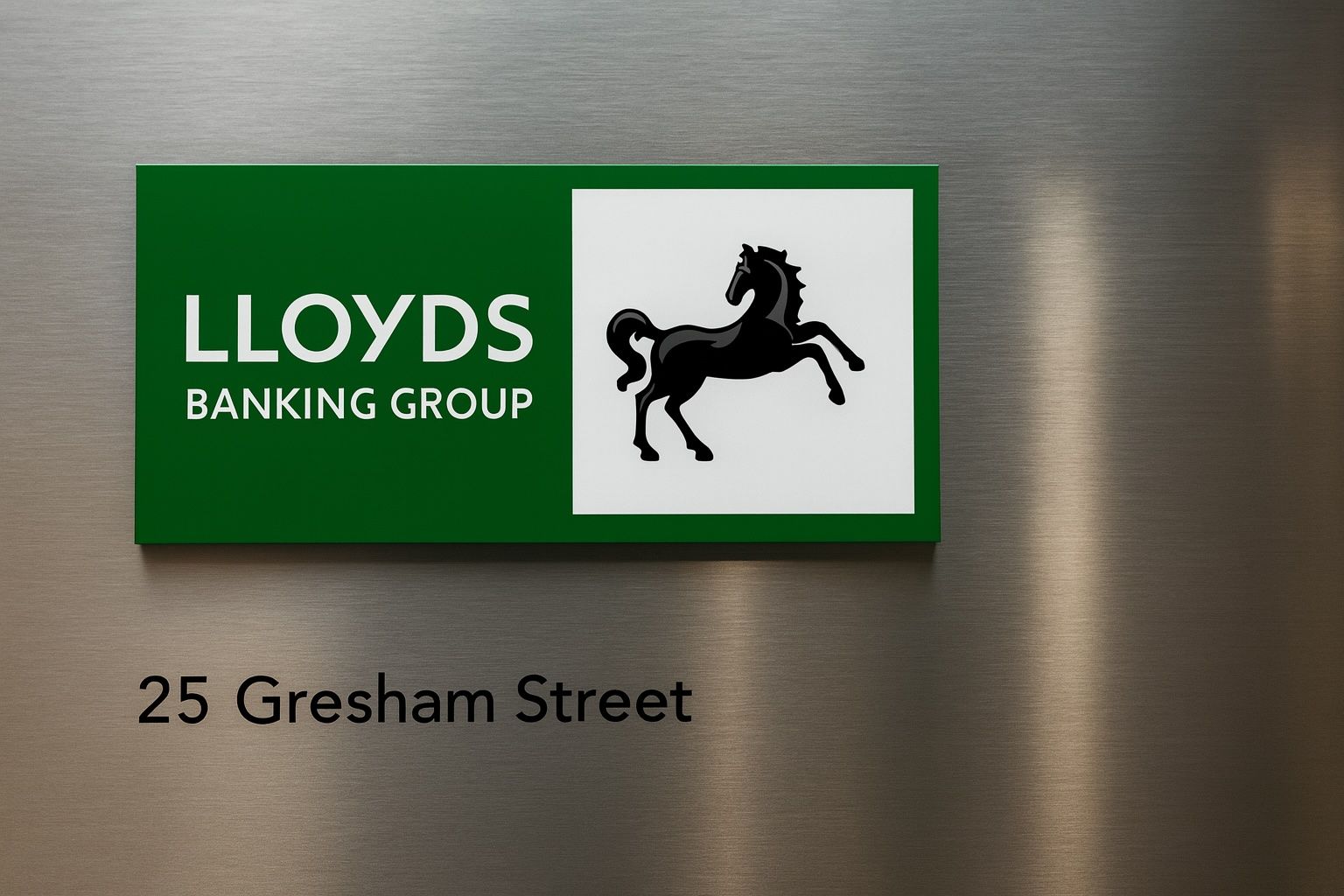- LLOY.L rallies amid volatility: Lloyds Banking Group shares traded around 84–86 pence on Friday (17 October 2025), rebounding from an early 3% drop and hovering near a 52-week high [1]. The stock is roughly flat on the day after a mid-session recovery, defying a broader bank selloff.
- Up ~50% in a year: Lloyds’ stock has surged ~50% over the past 12 months as high interest rates boosted bank profits [2]. It’s now at 10-year highs, levels not seen since before the 2016 Brexit vote, underscoring investor optimism.
- Motor finance scandal costs rise: The bank added £800 million to provisions for a UK car loan mis-selling scandal this week, lifting its total charge to £1.95 billion [3] [4]. Lloyds warned the extra costs could be “material,” but relief that the hit wasn’t larger helped shares rebound [5] [6].
- Solid earnings and dividend: First-half 2025 net interest income rose ~5% to £6.7 billion, bolstering profits [7]. Lloyds restored its dividend post-pandemic and yields ~4% annually, with analysts expecting payout growth into 2026–27 [8] [9].
- Analysts upbeat but cautious: City analysts on average target ~93p for Lloyds stock over 12 months [10]. Several brokers recently raised price targets into the high-90s pence [11]. While bullish on earnings and buybacks, experts note risks from higher defaults and competition in mortgages [12].
- Macro context: UK bank shares wobbled Friday as U.S. regional bank woes sparked a global selloff [13]. Barclays, NatWest and others slid 3–5% intraday. Yet Lloyds proved resilient, aided by a robust UK economy – August GDP returned to growth and the IMF sees Britain as a G7 growth leader in 2025 [14]. High interest rates continue to fatten lenders’ margins, though credit quality and regulatory scrutiny remain key concerns.
Market Rally Puts Lloyds Near Record Levels
Lloyds Banking Group (LON: LLOY) stock is flirting with decade highs after an impressive 2025 rally. Shares in the UK’s largest retail bank traded around 85 pence on 17 October – roughly unchanged from Thursday’s close – having recovered from a sharp fall earlier in the day [15]. In morning trade, Lloyds tumbled nearly 3% to about 82p amid a broad sell-off in financials, as fears over U.S. regional bank loan troubles rattled global markets [16]. By afternoon, however, Lloyds had clawed back those losses, reflecting its relative strength in a volatile session. The FTSE 100 index as a whole was down ~1.3% by midday, hitting a two-week low as oil majors and banks sank on risk-off sentiment [17].
Even with recent turbulence, Lloyds shares remain one of the FTSE 100’s standout performers over the past year. The stock has climbed roughly 50% in the 12 months to autumn 2025, according to TS2.tech’s analysis [18]. This steep gain far outpaces the FTSE benchmark and has lifted LLOY to levels last seen in 2015. In fact, the stock hasn’t been this high in about ten years, just shy of the pre-Brexit peak. Elevated interest rates have been a major tailwind – banks earn more on loans relative to deposit costs in a high-rate environment, boosting Lloyds’ net interest margin. The group’s H1 2025 results underscore this, with net interest income reaching £6.5–6.7 billion (up ~5% year-on-year) amid stable lending growth [19].
Investor sentiment toward Lloyds is also buoyed by its capital returns and dominant position in UK retail banking. The bank has resumed healthy dividends after the pandemic pause – it currently yields roughly 4%, and payouts are expected to rise further. Analysts forecast dividends per share of about 3.6p for 2025, 4.1p in 2026 and 4.8p in 2027, implying yields of 4–5.7% and confident earnings coverage of over 2× [20]. Lloyds is also partway through a sizeable share buyback program (over £2 billion announced for 2025), which enhances shareholder value and has contributed to the stock’s strong upward momentum.
£1.95 Billion Mis-Selling Scandal Provision – But Relief for Investors
A key development this week was Lloyds’ escalating bill for the motor finance mis-selling scandal, a long-running industry issue involving auto loans where customers were not properly informed of dealer commissions. On 9 October, the Financial Conduct Authority (FCA) proposed a sweeping £11 billion redress scheme to compensate affected UK car finance borrowers [21]. Lloyds, being a major player in vehicle financing, had already set aside £1.15 billion for this scandal but warned that additional “material” provisions were likely in light of the FCA’s plan [22] [23]. This alarmed the market – Lloyds’ shares sank about 2.7% on that warning [24], as investors braced for a bigger hit to the bank’s earnings.
Just days later, on 13 October, Lloyds quantified the damage. It announced an extra £800 million charge to cover motor finance redress, bringing its total provisions for this issue to £1.95 billion [25] [26]. While nearly £2 billion in compensation costs is enormous, the news actually offered clarity and a measure of relief. The final top-up was within expectations – analysts had estimated Lloyds would need roughly £1.5–1.8 billion in total [27] [28]. “There is some relief today that ‘material’ top-up didn’t equate to a much larger number,” noted Benjamin Toms, an analyst at RBC Capital, after Lloyds confirmed the £800 million figure [29]. Lloyds’ stock actually rose ~1.6% on 13 October in a relief rally [30], as investors were glad the provision wasn’t worse and the uncertainty began to clear.
Crucially, Lloyds signaled it will challenge the FCA’s methodology in calculating redress [31] [32]. The bank argues the regulator’s approach is “less closely linked to actual customer loss than anticipated,” suggesting the payout formula might be overly generous [33]. Lloyds and other lenders plan to lobby for adjustments to better align compensation with real harm caused. Even so, the industry-wide impact is significant – major UK banks and lenders have together provisioned only about £2 billion so far, a fraction of the £11 billion potential bill [34] [35]. A large portion of the total cost will hit auto manufacturers’ finance arms (“captive” lenders), but roughly half falls on banks [36]. Lloyds’ share, as the market leader, is the largest single chunk. Despite this headwind, the bank’s robust profitability and capital buffers (CET1 capital ratio ~14%) have reassured investors that it can absorb the charges [37]. Lloyds still expects to meet its performance targets for the year, and importantly, it did not revise its dividend or buyback plans in response to the scandal costs.
Analyst Forecasts: Can the Rally Continue?
Looking ahead, market watchers are divided on how much upside remains for Lloyds after its strong run. The consensus of City analysts points to a moderate rise from here – the average 12-month price target is around 93 pence, according to recent surveys [38]. That implies mid-single-digit percentage appreciation. A number of brokerages reiterated bullish stances in recent weeks: for instance, RBC Capital Markets has a 95p target, and Jefferies lifted its target to 103p (just above the £1 mark) [39]. JPMorgan is around 98p [40]. These targets reflect confidence that Lloyds’ earnings and return on equity will continue to improve through 2025–26. The bank is benefiting from stable net interest margins (forecast around 3.1% this year, possibly rising to ~3.3% by 2027) and widespread cost-cutting and digitalisation efforts, which should support profitability [41]. Moreover, Lloyds has been buying back shares (over £7 billion planned across 2024–2027 [42]), which boosts earnings per share growth.
However, few expect explosive near-term gains from here – the stock’s valuation is no longer a deep bargain. At ~84–86p, Lloyds trades at roughly 11–13 times forecast 2025 earnings [43], a richer multiple than some UK banking peers. As Good Money Guide noted, much of the good news may be priced in, and investors could be tempted to lock in profits after the big rally [44]. Indeed, despite many “Buy” ratings, some analysts have tempered their optimism with cautionary notes. Key risks cited include the economic outlook – high borrowing costs could eventually curb credit demand and drive up defaults if UK unemployment rises. Notably, Lloyds’ loan impairment charges have already been creeping up from very low levels: it booked £442 million of provisions in H1 2025, versus only £100 million a year earlier [45] [46]. Some forecasts see annual impairments potentially exceeding £1 billion again by 2027 if inflation and household finances deteriorate [47]. Additionally, competition in the mortgage and savings market is intense, putting pressure on net interest margins. And with a General Election on the horizon, there’s political risk – UK banks face populist scrutiny over their rising profits. Analysts have even flagged the outside chance of a windfall tax or stricter regulations if public sentiment turns against the sector’s profitability [48].
On balance, most experts believe Lloyds’ fundamentals remain strong. The bank’s core franchises (retail banking, mortgages, commercial lending, and insurance via Scottish Widows) are delivering steady returns. Lloyds is largely UK-focused, insulating it from some global turmoil, and it has minimal exposure to the higher-risk investment banking activities that have troubled some rivals. TS2.tech, in a recent deep dive, highlighted that despite near-term risks, Lloyds’ earnings per share could increase ~76% between 2024 and 2027 (helped by buybacks) and that dividends are set to grow at a double-digit pace annually [49] [50]. The stock offers both income and potential capital upside – a combination that has attracted institutional investors (several of whom raised their stakes this year) [51]. Still, investors will be watching upcoming results closely for any signs of strain.
Next week, all eyes turn to Lloyds’ Q3 results, due on 23 October. The bank’s CFO William Chalmers will present the third-quarter update on Thursday [52], and shareholders will scrutinize any changes to guidance. Given the backdrop – mixed UK economic signals but resilient consumer spending – the market will be keen to see if Lloyds maintains its full-year outlook. Any commentary on mortgage lending trends, deposit margins, or credit quality (post-summer) will be key for sentiment. Thus far, 2025 has been a year of earnings growth for Lloyds, and if the trend continued into Q3, it could reinforce the bullish case.
Wider UK Banking & Economic Backdrop
Lloyds does not operate in a vacuum, and recent developments in the broader banking sector and economy provide important context. This Friday’s market jitters were a stark reminder of contagion risks: news of two mid-sized U.S. banks suffering potential losses on fraudulent loans sent a chill through global financial stocks [53]. In London, banking giants like Barclays and Standard Chartered saw their shares plunge 4–5% in the morning flight from risk [54]. Lloyds’ dip was milder by comparison, possibly due to its domestic focus and the “known” nature of its motor finance issue (as opposed to an unexpected new problem).
UK banks have also had to navigate local regulatory and political pressures. Beyond the motor finance case, there was good news in August when the UK Supreme Court largely sided with banks on a separate consumer credit case, reducing potential liabilities [55]. Lloyds’ stock jumped on that ruling and even earned an upgrade to “Outperform” from RBC at the time [56] [57]. Additionally, lenders recently dodged a bullet on the prospect of windfall taxes: the UK government’s latest statements suggest no new bank-specific tax is imminent, easing a concern that had weighed on the sector earlier in the year. However, banks are making concessions elsewhere – under political pressure, many have raised savings account rates and eased branch closure plans to placate customers and lawmakers.
On the macro-economic front, conditions in Britain are somewhat mixed but not dire. Inflation, while down from 2022 peaks, remains above the Bank of England’s 2% target, which has kept interest rates elevated. The Bank of England’s key rate stands at 5.25%, the highest in 15 years, after a series of hikes aimed at taming prices. This has clearly benefitted banks’ net interest income in the short run. But officials are now openly debating the timing of future rate cuts – a sign that the tightening cycle is ending. The BoE’s Chief Economist Huw Pill this week urged “caution” on cutting rates too soon, emphasizing a need to decisively curb inflation [58]. For Lloyds, a pivot to lower rates in 2024 could gradually compress margins, though it might also stimulate loan demand.
The UK economy is proving more resilient than many anticipated. Fresh data showed GDP grew 0.2% in August, bouncing back from a July dip [59]. The International Monetary Fund now projects the UK will have the second-fastest growth in the G7 in 2025 (behind only the U.S.) [60]. Such trends bode well for loan volumes and credit performance at banks like Lloyds. Unemployment remains low (around 4.3%) and consumers, while stretched by high living costs, continue to spend and borrow at reasonable levels. House prices have cooled, but a feared crash has not materialized, which limits mortgage credit losses for Lloyds (the nation’s biggest mortgage lender). In short, the UK banking sector’s operating environment – moderate growth, high rates, and manageable credit quality – is relatively favorable.
Outlook: Cautious Optimism into Year-End
As of mid-October 2025, market sentiment on Lloyds Banking Group is cautiously optimistic. The bank’s stock has dramatically outperformed the broader market this year, thanks to robust earnings and investor confidence in management’s strategy. TS2.tech notes that fintech adoption and digital initiatives are also picking up across banks, with over half of financial firms planning to boost AI investments – a trend Lloyds is riding to cut costs and improve services [61]. Such innovation could be another value driver long-term, though it comes with its own challenges (including the need to reskill staff, as highlighted by reports of Lloyds shifting some IT jobs offshore to reduce expenses).
In the near term, analysts expect steady if unspectacular gains. Lloyds’ current valuation is undemanding relative to historical norms, and if economic outcomes align with forecasts (i.e. a soft landing with moderate growth and easing inflation), the bank’s profits should continue to grow into 2026. That could justify further share price appreciation, albeit likely at a slower pace than the past year’s 50% leap. Market volatility remains a factor – episodes like this week’s U.S. banking scare or global geopolitical tensions can swiftly dent confidence. And as a primarily UK-focused lender, Lloyds is heavily tied to domestic fortunes; any stumble in UK consumer finances or a policy mishap could hurt its outlook.
For now, however, Lloyds Banking Group appears to be on solid footing. It has navigated a major regulatory hurdle (the motor finance scandal) with manageable damage, and continues to churn out healthy profits. The bank’s common equity Tier-1 ratio near 14% indicates a strong capital position [62], providing a buffer against shocks and room for shareholder returns. Investor focus is shifting to growth: whether through lending, wealth management (Lloyds has been expanding in insurance and pensions), or potential acquisitions. There was even recent speculation – spurred by an RBC note – that Lloyds could target UK wealth manager Quilter as a takeover to broaden its franchise [63]. While just a rumor, it signals that the group is looking to the future.
In summary, Lloyds enters the final quarter of 2025 with considerable momentum. The share price is near its highest in a decade, supported by strong fundamentals and upbeat forecasts. Yet management and investors remain vigilant. As one market commentator put it, “spooked investors fear a crisis is brewing” whenever banking stocks slide [64] – a reminder that confidence can be fragile. Lloyds will aim to justify that confidence in its upcoming results and strategic moves. If it delivers as expected, the storied “black horse” bank could gallop further ahead, even as economic and regulatory hurdles loom on the path to its next milestone – perhaps the coveted £1.00 per share level that has eluded it for years.
Sources: Official filings and investor news from Lloyds Banking Group; Reuters, Alliance News and ShareCast financial reports [65] [66] [67]; TS2.Tech market analysis [68] [69]; The Motley Fool UK/Yahoo Finance commentary [70]; UK Finance sector updates (Bank of England, FCA) [71] [72]. All information is current as of 17 October 2025.
References
1. www.sharesmagazine.co.uk, 2. ts2.tech, 3. www.reuters.com, 4. www.reuters.com, 5. www.reuters.com, 6. www.reuters.com, 7. www.lloydsbankinggroup.com, 8. ts2.tech, 9. ts2.tech, 10. www.fool.co.uk, 11. ts2.tech, 12. ts2.tech, 13. www.reuters.com, 14. www.reuters.com, 15. www.sharesmagazine.co.uk, 16. www.reuters.com, 17. www.reuters.com, 18. ts2.tech, 19. www.lloydsbankinggroup.com, 20. ts2.tech, 21. www.reuters.com, 22. www.reuters.com, 23. www.reuters.com, 24. www.reuters.com, 25. www.reuters.com, 26. www.reuters.com, 27. www.reuters.com, 28. www.reuters.com, 29. www.reuters.com, 30. www.reuters.com, 31. www.reuters.com, 32. www.reuters.com, 33. www.reuters.com, 34. www.reuters.com, 35. www.reuters.com, 36. www.reuters.com, 37. ts2.tech, 38. www.fool.co.uk, 39. ts2.tech, 40. ts2.tech, 41. ts2.tech, 42. ts2.tech, 43. ts2.tech, 44. ts2.tech, 45. ts2.tech, 46. ts2.tech, 47. ts2.tech, 48. ts2.tech, 49. ts2.tech, 50. ts2.tech, 51. ts2.tech, 52. www.lloydsbankinggroup.com, 53. www.reuters.com, 54. uk.finance.yahoo.com, 55. www.hl.co.uk, 56. www.hl.co.uk, 57. www.hl.co.uk, 58. www.theguardian.com, 59. www.reuters.com, 60. www.reuters.com, 61. ts2.tech, 62. ts2.tech, 63. www.hl.co.uk, 64. www.standard.co.uk, 65. www.reuters.com, 66. www.reuters.com, 67. www.reuters.com, 68. ts2.tech, 69. ts2.tech, 70. www.fool.co.uk, 71. www.reuters.com, 72. www.reuters.com







